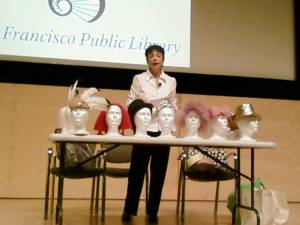Roslyn Donald, Business Librarian at San Mateo Public Library, and Jackie Nelson, Director of Events, Bel Mateo Bowl, did an effective presentation modeling some of the ways San Mateo Public reaches out to the local business community and draws them into the library user base. It was very plain that the two had a great working relationship and were comfortable with each other – proof that it is possible to create productive and mutually beneficial partnerships.
Roslyn pointed out that forming partnerships and serving local businesses is really serving yourselves. Small businesses create over 80% of all jobs in the U.S. With so many people laid off, taxes not paid by workers are not going into government and library coffers. Businesses who have been downsized have less money to spend on services, and are a ripe market for libraries. Her bottom line: “Find out where your movers and shakers are moving and shaking,” write your elevator speech, and get out among them: “I’m a small business consultant and I help businesses… and I’m also a librarian.” Another catchprase: “Your library card is really smart!
Jackie’s story was also compelling, as she is not a librarian, but a library user. “My ears pricked right up when I heard her say she could save me time and money!” Seeing Roslyn’s face outside the library puts her in a whole different light. After trading business cards, she had a face and a name – a contact – at the library that she could call. She recommends you talk in “business speak: “Would you like to find all the businesses within 2 miles?” “Write your business plan in no time using our database.”
Roslyn: Empty storefronts worry her; she works with the chamber of commerce to help fill them up. The top three resources she promotes to businesses: ReferenceUSA (all the businesses withng 2 miles), Business Decision (consumer purchasing patterns and power), and Small Business Resource Center (business plans).
Jackie: The bowling alley used to get demographics every couple of years, and the report cost $1500; now they get updated data any time, for free with a library card!
Roslyn: Staff training is crucial! Designate a go-to person that is identified with business resources, and make sure all staff knows how to refer patrons to the business librarian.
Jackie: Strongly urges libraries have the programs closer to home instead of in a central or downtown location. Being able to walk into the library and see a familiar face is important for good business relations. E-mail blasts are also effective. If you collect the e-mail addresses of your business leaders, you can “blast” them with announcements of new products and upcoming programs; advertise your services boldly on front page of your web site, don’t bury them meekly and modestly under layers of links.
Roslyn – Have a mixer at the library. The familiar format in a new place gives you an opportunity to showcase library services. She also has brown bag lunches once a month, and puts on small business workshops.
Q-What is the rate of business use for meeting rooms vs library programs?
A-There is a sliding-scale fee for meeting room use, so there is room for both kinds; be sure rooms have AV technology available. Libraries are cheaper than hotels, so you should get some interest.
Q-Linked-in, FaceBook, Twitter?
A- Monitor your contacts and friends, and answer queries by referring them to local libraries.
Q- How much time do you spend in and outside the library contacting businesses? how many businesses each month?
A-2-3 hrs /month on average, 15-30 businesses, new and repeat. Mixing helps cement your face in the community. Find out where the movers are and show up there; it might not be the Chamber – might be Toastmasters, Rotary…
Q-Do you look for speaking engagements?
A-Yes.


